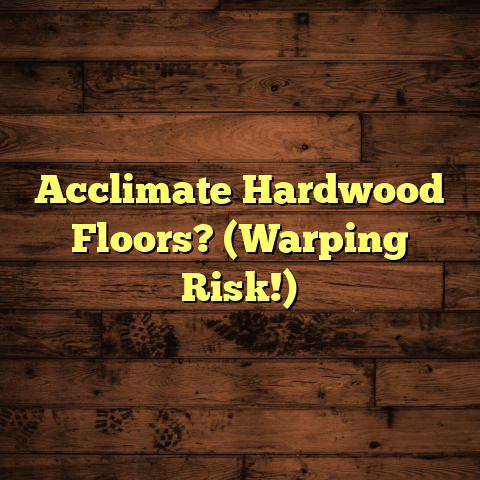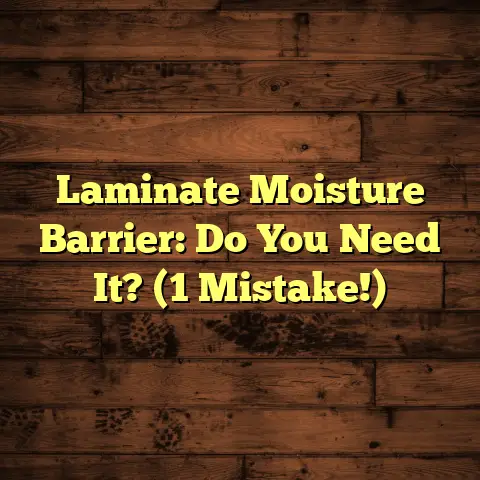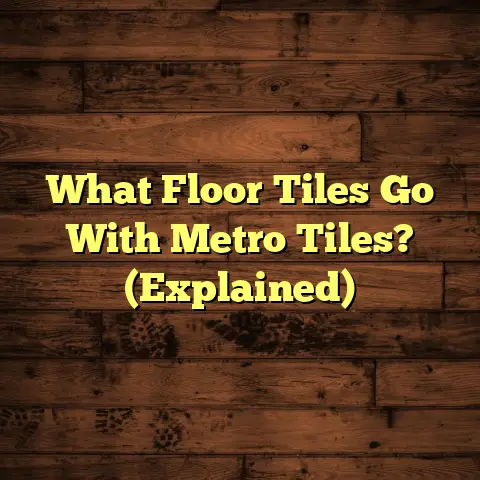Garage Floor Coverings (Top 5 Now!)
Garages aren’t just for parking cars anymore. We’re talking workshops, home gyms, hobby spaces, and even extra living areas.
That’s why choosing the right garage floor covering is crucial. It’s not just about looks; it’s about durability, functionality, and making your life easier.
A good floor can seriously boost your home’s value and make your garage a place you actually want to spend time in. So, let’s dive into the top 5 garage floor coverings that are trending right now!
Section 1: Epoxy Floor Coatings: The King of Durability
What exactly is epoxy? Well, it’s a thermosetting resin that, when mixed with a hardener, creates a super strong, durable surface.
Think of it as liquid plastic that bonds tightly to your concrete floor. This creates a seamless and beautiful finish.
Why Epoxy Rocks:
-
Durability: Epoxy floors are tough! They can handle heavy foot traffic, dropped tools, and even the weight of your car without cracking or chipping.
-
Stain and Chemical Resistance: Spilled oil? No problem! Epoxy resists stains from oil, grease, chemicals, and even road salt.
-
Seamless Finish: Say goodbye to cracks and crevices that collect dirt. Epoxy creates a smooth, easy-to-clean surface.
-
Aesthetic Appeal: You’re not stuck with boring gray. Epoxy comes in tons of colors, flakes, and metallic effects to match your style.
Lifestyle Scenarios: Where Epoxy Shines
-
The Workshop Warrior: If you’re a DIY enthusiast, epoxy is your best friend. It can handle dropped tools, spilled paint, and the constant wear and tear of a busy workshop.
-
The Family Fun Zone: Turn your garage into a playroom or extra living space. Epoxy is easy to clean, so you don’t have to worry about spills or messes.
-
The Car Enthusiast’s Dream: Show off your prized vehicle on a showroom-worthy epoxy floor. The glossy finish will make your car look even better!
Installation, Costs, and Maintenance
Installation: Epoxy installation usually involves a few steps:
-
Surface Prep: This is key! The concrete needs to be clean, dry, and free of any cracks or damage. Grinding or acid etching may be needed.
-
Primer: A primer helps the epoxy bond to the concrete.
-
Epoxy Application: The epoxy is mixed and applied in thin, even coats.
-
Topcoat (Optional): A topcoat adds extra durability and shine.
Cost: Expect to pay anywhere from $3 to $7 per square foot for professional epoxy installation. DIY kits are available, but the results may not be as durable or long-lasting.
Maintenance: Epoxy is super easy to maintain. Just sweep or mop regularly with a mild soap and water. Avoid harsh chemicals or abrasive cleaners.
My Experience with Epoxy
I’ve installed countless epoxy floors, and I’m always impressed with the results. One time, a client used his garage as a woodworking shop.
He was constantly dropping tools and spilling stains. After I installed an epoxy floor, he called me back to say it was the best investment he’d ever made.
He said cleanup was a breeze, and the floor still looked great after years of heavy use.
Section 2: Garage Floor Tiles: The Versatile Option
Garage floor tiles are another fantastic option for upgrading your garage. We’re talking about different types like interlocking tiles, vinyl tiles, and even porcelain tiles designed for garage use.
Why Tiles Are a Great Choice
-
Easy Installation: Many tiles, especially interlocking ones, are designed for DIY installation. You can snap them together without glue or special tools.
-
Design Versatility: Tiles come in a huge range of colors, patterns, and textures. You can create custom designs and even mimic the look of stone or wood.
-
Repairability: If a tile gets damaged, you can simply replace it without having to redo the entire floor.
-
Load-Bearing Capacity: Garage floor tiles are designed to withstand heavy loads, making them perfect for parking cars, storing equipment, and working on projects.
Lifestyle Applications: Tiles in Action
-
The Home Gym Hero: Create a comfortable and durable workout space with rubber or PVC tiles. They provide cushioning and shock absorption for your joints.
-
The Modern Minimalist: Achieve a sleek, contemporary look with large-format porcelain tiles. They’re easy to clean and add a touch of elegance to your garage.
-
The Gearhead’s Paradise: Use interlocking tiles with a textured surface to create a safe and slip-resistant workspace for car repairs and maintenance.
Installation, Costs, and Maintenance
Installation: Interlocking tiles are super easy to install. Just snap them together like puzzle pieces. Vinyl tiles may require adhesive, and porcelain tiles require mortar and grout.
Cost: Expect to pay anywhere from $2 to $10 per square foot for garage floor tiles, depending on the material and style.
Maintenance: Tiles are easy to clean. Sweep or mop regularly with a mild detergent. For grout lines, use a grout brush and cleaner to remove dirt and stains.
Tiles vs. Epoxy: A Quick Comparison
| Feature | Epoxy | Tiles |
|---|---|---|
| Installation | More complex, requires surface prep | Easier, especially interlocking tiles |
| Durability | Excellent, resists chemicals and stains | Good, but can be damaged by sharp objects |
| Design Options | Wide range of colors and flakes | Wide range of colors, patterns, and textures |
| Repairability | Difficult to repair individual spots | Easy to replace damaged tiles |
| Cost | Generally more expensive than basic tiles | Varies, can be cheaper or more expensive |
My Tile Story
I once helped a client transform his garage into a home gym. We used interlocking rubber tiles to create a comfortable and safe workout space.
He loved the way the tiles looked and felt under his feet. He said it made working out in his garage much more enjoyable.
Section 3: Polyaspartic Coatings: The Speedy Solution
Polyaspartic coatings are like epoxy’s faster, tougher cousin. They’re a type of coating that cures incredibly quickly and offers excellent durability.
What Makes Polyaspartic Special?
-
Rapid Curing Time: Polyaspartic coatings can cure in as little as a few hours, meaning you can get back to using your garage much sooner.
-
UV Stability: Unlike epoxy, polyaspartic coatings are resistant to UV rays, so they won’t yellow or fade over time.
-
Flexibility: Polyaspartic coatings are more flexible than epoxy, making them less likely to crack or chip in extreme temperatures.
-
Temperature Resistance: Polyaspartic coatings can withstand extreme temperatures, making them ideal for garages in hot or cold climates.
Lifestyle Scenarios: Polyaspartic in Action
-
The Busy Bee: If you need to get your garage floor done quickly, polyaspartic is the way to go. You can have a brand new floor in a single day!
-
The Outdoor Enthusiast: If you live in a climate with extreme temperatures, polyaspartic will hold up better than epoxy.
-
The Showroom Style: Polyaspartic coatings offer a high-gloss, professional finish that’s perfect for showcasing your vehicles or creating a stylish workspace.
Installation, Costs, and Maintenance
Installation: Polyaspartic coatings require professional installation. The surface needs to be properly prepped, and the coating needs to be applied quickly and evenly.
Cost: Expect to pay anywhere from $5 to $10 per square foot for polyaspartic installation.
Maintenance: Polyaspartic coatings are easy to maintain. Just sweep or mop regularly with a mild soap and water.
Polyaspartic vs. Epoxy: The Showdown
| Feature | Epoxy | Polyaspartic |
|---|---|---|
| Curing Time | Longer, typically several days | Very fast, often within hours |
| UV Stability | Can yellow or fade over time | Resistant to UV rays |
| Flexibility | Less flexible, prone to cracking | More flexible, less prone to cracking |
| Temperature Resistance | Less resistant to extreme temperatures | More resistant to extreme temperatures |
| Cost | Generally less expensive | Generally more expensive |
My Polyaspartic Experience
I recently installed a polyaspartic floor for a client who ran a small auto repair shop out of his garage. He needed a durable, chemical-resistant floor that could withstand heavy use.
He was amazed by how quickly the polyaspartic coating cured. He was back to work the very next day!
Section 4: Rubber Floor Mats: The Budget-Friendly Option
Rubber floor mats are a simple and affordable way to protect your garage floor. They come in various styles, including rolled rubber and interlocking mats.
Why Choose Rubber Mats?
-
Shock Absorption: Rubber mats provide cushioning and shock absorption, making them ideal for home gyms or workshops.
-
Slip Resistance: Rubber mats offer excellent traction, even when wet, making them a safe option for garages.
-
Easy to Clean: Rubber mats are easy to clean with a hose or mop.
-
Cost-Effective: Rubber mats are one of the most affordable garage flooring options.
Lifestyle Scenarios: Rubber Mats in Action
-
The Home Gym Enthusiast: Create a comfortable and safe workout space with rubber mats. They protect your floor from dropped weights and provide cushioning for your joints.
-
The DIY Dad: Use rubber mats to create a soft and safe play area for your kids in the garage.
-
The Parking Pad: Place rubber mats under your car to protect your concrete floor from oil spills and tire marks.
Installation, Costs, and Maintenance
Installation: Rubber mats are super easy to install. Just roll them out or snap them together.
Cost: Expect to pay anywhere from $1 to $5 per square foot for rubber mats, depending on the thickness and style.
Maintenance: Rubber mats are easy to clean. Just sweep or hose them down.
Types of Rubber Mats
-
Rolled Rubber: Comes in long rolls that you can cut to fit your garage.
-
Interlocking Mats: Snap together like puzzle pieces, making them easy to install and customize.
-
Anti-Fatigue Mats: Designed to reduce fatigue and discomfort when standing for long periods.
My Rubber Mat Story
I helped a client set up a home gym in his garage. We used interlocking rubber mats to create a comfortable and safe workout space.
He loved how easy the mats were to install and clean. He said they made his garage feel like a real gym.
Section 5: Concrete Stains and Sealers: The Budget-Friendly Option
Concrete stains and sealers are a great way to enhance the look of your existing concrete floor without breaking the bank.
What Are Concrete Stains and Sealers?
-
Concrete Stains: Penetrate the concrete surface to add color and depth. They come in a variety of colors, from subtle earth tones to bold, vibrant hues.
-
Concrete Sealers: Protect the concrete from moisture, stains, and wear. They also enhance the color and shine of the stained concrete.
Why Choose Stains and Sealers?
-
Aesthetic Appeal: Stains and sealers can transform a plain concrete floor into a beautiful and stylish surface.
-
Protection: Sealers protect the concrete from moisture, stains, and wear, extending its lifespan.
-
Cost-Effective: Staining and sealing is one of the most affordable ways to upgrade your garage floor.
Lifestyle Scenarios: Stains and Sealers in Action
-
The Chic Garage: Transform your garage into a stylish entertaining space with stained and sealed concrete floors.
-
The Polished Workshop: Create a durable and easy-to-clean workspace with stained and sealed concrete floors.
-
The Showroom Style: Enhance the look of your vehicles with a glossy, stained and sealed concrete floor.
Application, Costs, and Maintenance
Application: Staining and sealing concrete requires careful preparation. The concrete needs to be clean, dry, and free of any cracks or damage.
- Cleaning: Thoroughly clean the concrete surface.
- Staining: Apply the stain evenly using a brush, roller, or sprayer.
- Sealing: Apply a sealer to protect the stained concrete.
Cost: Expect to pay anywhere from $1 to $4 per square foot for staining and sealing concrete.
Maintenance: Stained and sealed concrete is easy to maintain. Just sweep or mop regularly with a mild soap and water.
Types of Concrete Stains
-
Acid-Based Stains: React with the concrete to create a permanent, mottled finish.
-
Water-Based Stains: More environmentally friendly and offer a wider range of colors.
My Staining and Sealing Story
I helped a client transform his boring garage into a cool hangout spot for his teenagers. We used a water-based stain to create a modern, industrial look.
He was thrilled with the results. He said his kids loved hanging out in the garage, and he didn’t have to worry about them damaging the floor.
Conclusion
Choosing the right garage floor covering is a big decision. Consider how you’ll be using your garage and what your aesthetic preferences are.
Each of these options – epoxy, tiles, polyaspartic, rubber mats, and stains & sealers – offers unique benefits.
Investing in quality materials will not only enhance the functionality of your garage but also add value to your home. So, go ahead and create a garage space that reflects your personal style and serves your practical needs!
I hope this guide has been helpful. If you have any questions or need further assistance, don’t hesitate to reach out!





